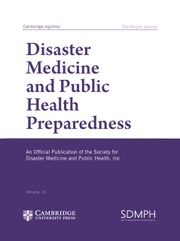No CrossRef data available.
Article contents
Effectiveness of Disaster Nursing Education Programs: A Meta-Analysis Focused on Knowledge, Attitude, and Skill Domains
Published online by Cambridge University Press: 25 September 2025
Abstract
Disaster preparedness is a critical component of nursing education as nurses are expected to respond effectively to public health emergencies. Various disaster nursing education programs have been developed globally, but their effectiveness across cognitive, affective, and psychomotor domains remains unclear. This meta-analysis evaluated the overall impact of these programs across learning domains.
Eleven experimental or quasi-experimental studies involving nursing students and nurses were included. The pooled effect size was calculated using Hedges’ g. Heterogeneity was assessed using Cochran’s Q and the I2 statistic. Subgroup analyses were conducted by learning domain. Publication bias was assessed via a funnel plot.
The overall effect size was large (Hedges’ g = 1.80, 95% CI: 1.491-2.399, P < .001). Heterogeneity was high (Q = 377.91, P < .001, I2 = 97.4%). The affective domain showed the strongest effect (g = 2.96), followed by psychomotor (g = 1.98) and cognitive (g = 0.66). The funnel plot showed minimal publication bias.
Disaster nursing education programs significantly improve learning outcomes across domains, especially in attitudes and practical skills. These findings support the need for integrated curricula in nursing education.
Information
- Type
- Original Research
- Information
- Copyright
- © The Author(s), 2025. Published by Cambridge University Press on behalf of Society for Disaster Medicine and Public Health, Inc

